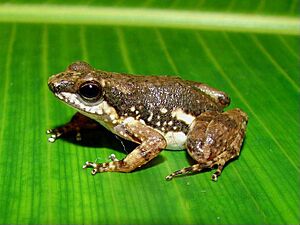Colostethus inguinalis facts for kids
Quick facts for kids Colostethus inguinalis |
|
|---|---|
 |
|
| Conservation status | |
| Scientific classification | |
| Synonyms | |
|
Prostherapis inguinalis Cope, 1868 |
The Colostethus inguinalis is a small frog that belongs to the Dendrobatidae family. This family includes many colorful poison dart frogs. This frog is special because it is found only in certain parts of Colombia, a country in South America. People often call it the common rocket frog. However, sometimes another frog, Colostethus panamansis, is also called by this name. For a long time, scientists thought these two frogs were the same!
What Does This Frog Look Like?
These frogs are quite small. Adult male Colostethus inguinalis frogs are about 22 to 27 millimeters long. Female frogs are a bit larger, measuring about 23 to 30 millimeters long. This measurement is from their snout (nose) to their vent (bottom).
This frog has a clear tympanum, which is like an eardrum. It is pale in the front. A light-colored line runs from the frog's groin (where its leg meets its body) halfway up to its eye.
Male frogs have a solid black throat. This black color often spreads onto their chest and the front part of their belly. Female frogs, however, have a white chest. Sometimes their chest might be a light gray or brown color. Their toes have some webbing, which helps them move in water. Adult male frogs also have a slightly swollen third finger.
Where Does This Frog Live and How Is It Doing?
The Colostethus inguinalis frog is active during the day. It lives in humid lowland forests. You can find it at different heights, from sea level up to 800 meters above sea level. These frogs often live near rocky parts of forest streams.
Female frogs lay their eggs in leaf litter on the forest floor. After the eggs hatch, the adult frogs carry the tiny tadpoles on their backs. They take them to streams, where the tadpoles continue to grow.
This frog species is quite common. However, its home is facing some threats. People are cutting down forests to create farms and build new homes. Logging also removes trees. Illegal crops and pollution from spraying these crops also harm the frogs' environment. Scientists believe that the number of these frogs is slowly going down. Luckily, you can find this frog in several protected areas, which helps keep them safe.


